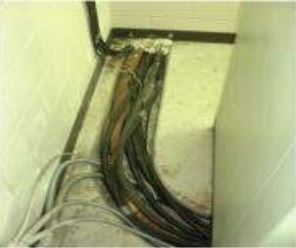Critter Control

[November 2012] Many stations have mascots, or even station pets – a dog here, a cat there.
Beyond that, animals are probably not the best tenants to have. Evicting them can be a pain. Jeff Welton offers some ideas on how to prevent them from coming in the first place.
It is that time of year when insects and animals from rodents to spiders to snakes, and more, seek warmer places to spend the winter. Some may be visiting your station. Transmitter sites rate particularly high on the list of warm, cozy places to stay.
Perhaps you may be a card-carrying member of PETA or have other reasons for not interfering with where animals want to settle. Or maybe you find having a dog or cat around to eat any intruders is the “natural way” to take care of such pests.
On the other hand, non-human residents could bring negative ramifications to the health of station staff (examples: spider bites or infections from animal waste), to operations, or even cause equipment failure – and unpleasant odors!
Winterizing Things
Winterizing your studio – and especially your transmitter site – to cut down on access points is a good idea.
Nothing can mess up a transmitter faster than a three-inch-long mouse nibbling wires and doing … well doing what mice do besides eat, in the electronics. Occasionally more pungent and destructive are the remains of a snake getting across an HV supply (or any power supply/RF connection, for that matter).
While it is easy to call the exterminator when you do find signs of infestation, preventing animal ingress as much as possible will reduce the problems with which you will need to deal. In fact, as a year-round maintenance point, winterizing will also reduce dust and other airborne contaminants as well.
Close The Holes
The first step is to make as many holes as you can find in the building less inviting to potential entrants.
Start by checking the doors and the areas around the ceiling and roof. And do not forget the entry points for coax, cables, and other wiring.
Here are a couple of additional suggestions that I have picked up over the years to make the site less hospitable to insects and animals.
Steel wool (Brillo pads or similar) is your friend when it comes to blocking entry holes in exterior walls and foundations. Apparently, most of the little critters do not like to chew through it so it is a good way to keep them out.
Remember, though, that if you use steel wool will rust and needs to be replaced fairly regularly. Some find stainless steel wool or bronze wool (usually available through gun dealers) is better because they will not rust. In a pinch, you can even buy stainless steel pads at the grocery store.
Another idea is moth balls. I am sure several politically incorrect thoughts come to the minds of several, but I am referring to the naphthalene or benzene based pest repellents. These have proven to work wonders for keeping away several of our crawling/ slithering/ creeping/ flying friends.
At a few bucks a box, scattering moth-balls them in the corners of the building and in floor trenches is pretty cheap equipment protection.
To keep things neater, you can try using a glass jar, punching holes in the top to allow the fumes to permeate the area. This works well in any cabinet, including those ATUs out in the field. Just remember to seal the boxes as well as possible to keep the repellent inside the boxes.
Of course, given the size – and ingenuity – of many animals, even the smallest crack can provide entry. That is why you need a second line of defense.
Second Defense
Once you have put steel wool, for example, in a pipe or conduit, it is good idea to use one of those “instant foaming” cans to fill any excess conduit space.

Foam coax entry points to keep critters out
Products like that are simple and easily removed and replaced if you need to add more coax or cables.
– – –
Jeff Welton is the Nautel Sales Manager for the Central Region of the US. A veteran of many on-site trips to help customers, Jeff is always ready to help.
Contact Jeff at jwelton@nautel.com
